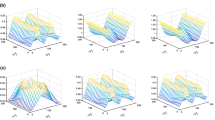Abstract
Combining the symplectic variations theory, the homogeneous control equation and isoparametric element homogeneous formulations for piezothermoelastic hybrid laminates problems were deduced. Firstly, based on the generalized Hamilton variation principle, the non-homogeneous Hamilton canonical equation for piezothermoelastic bodies was derived. Then the symplectic relationship of variations in the thermal equilibrium formulations and gradient equations was considered, and the non-homogeneous canonical equation was transformed to homogeneous control equation for solving independently the coupling problem of piezothermoelastic bodies by the incensement of dimensions of the canonical equation. For the convenience of deriving Hamilton isoparametric element formulations with four nodes, one can consider the temperature gradient equation as constitutive relation and reconstruct new variation principle. The homogeneous equation simplifies greatly the solution programs which are often performed to solve nonhomogeneous equation and second order differential equation on the thermal equilibrium and gradient relationship.
Similar content being viewed by others
References
Pagano N J. Exact solutions for rectangular bidirectional composites and sandwich plates[J]. Journal of Composite Materials, 1970, 4(1): 20–34.
Ray M C, Rao K M, Samanta B. Exact solution for static analysis of an intelligent structure under cylindrical bending[J]. Computers and Structures, 1993, 47(6): 1031–1042.
Batra R C, Liang X Q. Vibration of a rectangular laminated elastic plate with embedded piezoelectric sensors and actuators[J]. Computer and Structures, 1997, 63(2): 203–216.
Ray M C, Bhattacharya R, Samanta B. Exact solutions for dynamic analysis of composite plate with distributed piezoelectric layers[J]. Compute and Structures, 1998, 66(6): 737–743.
Vel S S, Batra R C. Generalized plane strain thermopiezoelectric analysis of multilayered plates[J]. Journal of Thermal Stresses, 2003, 26(4): 353–377.
Heyliger P R, Brooks P. Exact solution for laminated piezoelectric plates in cylindrical bending[J]. Journal of Applied Mechanics, 1996, 63(6): 903–910.
Xu K, Noor A K, Tang Y Y. Three-dimensional solutions for coupled thermoelectroelastic response of multilayered plates[J]. Computer Methods in Applied Mechanics and Engineering, 1995, 126(3/4): 355–371.
Ootao Y, Tanigawa Y. Control of transient thermoelastic displacement of a two-layered composite plate constructed of isotropic elastic and piezoelectric layers due to nonuniform heating[J]. Archive of Applied Mechanics, 2001, 61(4/5): 207–230.
Tarn Jiann-Quo. A state space formalism for piezothermoelasticity[J]. International Journal of Solids and Structures, 2002, 39(20): 5173–5184.
Kapuria S, Dumir P C. Sengupta S. Three-dimensional solution for shape control of a simply supported rectangular hybrid plate[J]. Journal of Thermal Stresses, 2003, 22(2): 159–176.
Zhang C, Cheung Y K, Di S, Zhang N. The exact solution of coupled thermoelectroelastic behavior of piezoelectric laminates[J]. Computers and Structures, 2002, 80(13): 1201–1212.
Ding H J, Wang H M, Ling D S. Analytical solution of a pyroelectric hollow cylinder for piezothermoelastic axisymmetric dynamic problems[J]. Journal of Thermal Stresses, 2003, 26(3): 261–276.
Zhong Wanxie. A new systematic for theory of elasticity[M]. Dalian: Dalian University of Technology Press, 1995 (in Chinese).
Zhong Wanxie. Symplectic system of applied mechanicas[M]. Beijing: Science Press, 2003 (in Chinese).
Qing Guanghui, Qiu Jiajun, Liu Yanhong. Modified H-R variational principle for magnetoelectroelastic bodies and state-vector equation[J]. Applied Mathematics and Mechanics (English Edition), 2005, 26(6): 722–728.
Gu Yuanxian, Chen Biaosong, Zhang Hongwu. Precise time-integration with dimension expanding method[J]. Acta Mechanica Sinca, 2000, 24(4): 447–456 (in Chinese).
Author information
Authors and Affiliations
Corresponding author
Additional information
Communicated by ZHONG Wan-xie
Project supported by the National Natural Science Foundation of China (No. 50276041)
Rights and permissions
About this article
Cite this article
Liu, Yh., Zhang, Hm. Variation principle of piezothermoelastic bodies, canonical equation and homogeneous equation. Appl Math Mech 28, 193–200 (2007). https://doi.org/10.1007/s10483-007-0207-y
Received:
Revised:
Issue Date:
DOI: https://doi.org/10.1007/s10483-007-0207-y
Key words
- piezothermoelasticity
- Hamilton principle
- Hamilton canonical equation
- symplectic variables
- homogeneous equation
- homogeneous isoparametric element formulations




